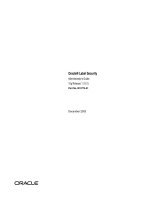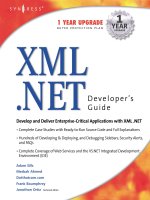Dr. Paula''''s Good Nutrition Guide docx
Bạn đang xem bản rút gọn của tài liệu. Xem và tải ngay bản đầy đủ của tài liệu tại đây (18.94 MB, 207 trang )
Drfigu&'s
Good Nutrition Guide
ALSO BY PAULA M. ELBIRT, M.D.
Dr. Paula's House Calls to Your Newborn
365 Ways to Get Your Child to Sleep
(with Linda Lee Small)
The Seventeen Guide to Sex and Your Body
(with Sabrina Solin)
A New Mother's Home Companion
(with Linda Lee Small)
0 td
for Babies,
Toddlers,
and
Preschoolers
Paula
M.
Elbirt,
M.D.,
FAAP
PERSEUS PUBLISHING
Cambridge. Massachusetts
Dr. Paula's
Good Nutrition Guide
Many of the designations used by manufacturers and sellers to distinguish
their products are claimed as trademarks. Where those designations appear in
this book and Perseus Publishing was aware of a trademark claim, the
designations have been printed in initial capital letters.
Copyright © 2001 by Paula M. Elbirt, xVl.D.
All rights reserved. No part of this publication may be reproduced, stored in a
retrieval system, or transmitted, in any form or by any means, electronic,
mechanical, photocopying, recording, or otherwise, without the prior written
permission of the publisher. Printed in the United States of America.
Note: The information in this book is true and complete to the best of our
knowledge. This book is intended only as an informative guide for those
wishing to know more about nutrition for children. In no way is this book
intended to replace, countermand, or conflict with the advice given by your
child's own pediatrician. The ultimate decision concerning care should be
made between you and your child's doctor. We strongly recommend you
follow his or her advice. The information in this book is general and is offered
with no guarantees on the part of the author or Fisher Books. The author and
publisher disclaim all liability in connection with the use of this book. The
names and identifying details of people associated with events described in this
book have been changed. Any similarity to actual persons is coincidental.
Cataloging-in-Publication data for this book is available from the Library of
Congress.
ISBN 0-55561-305-5
Perseus Publishing is a member of the Perseus Books Group.
Find us on the World Wide Web at
Perseus Publishing books are available at special discounts for bulk purchases
in the United States by corporations, institutions, and other organizations. For
more information, please contact the Special Markets Department at the
Perseus Books Group, 11 Cambridge Center, Cambridge, MA 02142, or call
(800) 255-1514.
Text design by Cindy Young
Set in 11-point Sabon
First printing, June 2001
1234 5 6789 10—04 03 02 01
Contents
Introduction vii
Part One How to Feed Your Child
1 Food for Thought: The Ten Commandments 3
2 Infants: The Beginning 13
3 Introducing Solid Foods 27
4 Infant Roadblocks 47
5 Toddlers 59
6 Toddler Roadblocks 75
7 Preschoolers 93
o Preschooler Roadblocks 107
9 Feeding the Sick Child 119
v
vi Contents
Part Two Food Facts and Fictions
10 The Food Pyramid Explained 129
11 The Good and Bad "Moos" About Milk 143
12 Junk Food 151
13 The Couch Potato and Childhood Obesity 167
14 Is Our Food Safe? Pesticides, Preservatives,
Additives, and Germs 175
The Last Word. . . 187
Acknowledgments 189
Index 191
Introduction
.^SJ^s I was walking between examination rooms recently, I
wished that I could introduce the family in exam room A to the
family in exam room B. The children in both rooms had food-
related "issues"—one was a picky eater and the other was what
I dub a "dessert monster." Both children had a couple of rather
desperate parents. I knew that if the two families could meet,
they would be greatly reassured to know they were not alone.
A good deal of my practice consists of listening to parents'
questions—often those I've answered many, many times before.
Particularly on weekends and evenings, parents will call
apologetically ("I know this really isn't an emergency, but I
wanted to run this by you"). Parents often need the answers to
their questions at the time they occur. ("This may sound silly,
but my four-year-old son will eat only 'white' food this week. Is
that normal?") As one parent said wistfully, "Dr. Paula, I really
wish all this information were in a book and then I wouldn't
have to keep bothering you." I wrote this book with these
parents in mind.
1 want to point out that although this book is divided into
sections by age, every parent must keep one overriding fact in
ru
viii Introduction
mind: No two children are alike. Children are born with
temperaments. Some are picky eaters from birth; others eat
anything not nailed down. Generally your child will arrive in
this world fitting more or less into one of the following
categories:
• The grazer. This is a particularly common style for
toddlers who "munch" as they toddle about.
• The ruminator. Ruminators are children who put food
in their mouths, but hardly ever swallow. (It's an hour
later, and the mashed potatoes are still in his mouth.)
This child may become a picky eater.
• The barracuda. This eater rolls through the table at
dinnertime—maybe eating off of every family member's
plate. This child can consume large amounts of food
and may be destined to be obese.
• The stuffer. As the name implies, the child eats quickly
(as if a sibling is poised to come by and steal his food)
and stuffs lots of different foods into his mouth.
(Stuffers often complain of stomachaches.) This child
may end up being an overeater.
It's part of the nature of children that eating habits often
change as the child grows older—a two-year-old grazer may
transform into a four-year-old barracuda. Not to worry!
The most critical "ingredient" in a book about nutrition is
actually a sense of humor. Always bring along your sense of
whimsy. To that end I offer an anonymous gift from my web
site.
Visit my web site at www.drpaula.com and click on "Ask
the Pediatrician," then go to "Topics" and click on "Diet,
Toddler" to read the Toddler Miracle Diet. Enjoy and, of
course, "take with a grain of salt."
f mi WE
How to Feed Your Child
This page intentionally left blank
Food
for Thought:
The Ten
Commandments
^/ £/(yeet Jane and John Smith. (The names have been
changed to protect the nutritionally challenged.) You know
them; they probably live next door to you or down the block.
The Smiths have four children under the age of five. I'm their
pediatrician. The youngest is ten-month-old Tommy, their pride
and joy. He's a "no-brainer" in terms of feeding. Jane reports
that Tommy lets her know exactly when he is hungry. "All he
has to do is cry. I feed him and he's happy." In fact, Tommy is
so easy compared to the other kids that Jane smiles a lot at him
and says, "Mommy loves you" with each bite of food.
Then there are the two-and-a-half-year-old twin toddlers, Jack
and Jill. Jack eats everything in sight—if it's not nailed down,
it's swallowed. Jane is a little concerned about how much Jack
eats.
She says, "Lately I have tried rewarding him when he eats
food like veggies, and I take away TV time when he eats too
much junk." Jack has been drinking skim milk since his first
birthday. In fact, he still drinks six bottles a day!
J
4
How to Feed Your Child
Jack can often be found eating in front of the TV with his
dad, John. At the end of the day, John often reaches for the
remote and sometimes for a can of soda. He loves this
opportunity to bond with Jack, and occasionally baby Tommy is
right beside them on the couch as well. Jack likes to share chips
with his dad, so Jane always makes sure to leave out a bowl of
nachos.
Jill,
the other twin, is a picky eater. Make that a very picky
eater. Some days it seems that all she eats is "round food"—a
few Cheerios and a couple of berries. Mom lets Jill have as
many bottles of milk as she wants because she figures, "Calories
are calories, and I know she's got to be healthy from all that
milk."
The preschooler, Lilly, is what I call a perfect "four." At four
years old she weighs forty pounds and is forty inches tall. Like
her little sister, she has some unusual eating habits, like insisting
that her sandwich be cut into perfect stars. And she is also your
classic "dessert monster." Many nights the only food she will eat
is dessert. Even though Lilly isn't skinny, mom is worried that
she could starve. "If she eats dessert, then at least she's getting
some calories. Sometimes she won't eat all day unless she gets
dessert first. One day I was so scared, I actually promised her a
new Barbie doll if she would just swallow some peas."
Recently mom brought in all four kids for checkups. When 1
asked if she had any particular concerns, Jane confessed, "I
know all kids should eat three meals a day, but my kids never
seem interested in food when I'm ready to serve it. I think
Tommy and Jack are basically OK—they both eat a lot. The
ones I'm really worried about are Jill and Lilly. Do you have any
advice?"
Oh, yes I do! First, Jane and John have to take a giant step
out of the kitchen to reassess what's happening. You know what
Food
for
Thought:
The Ten Commandments
5
they say about "good intentions." The Smiths are paving their
way right down the road to nutritional disaster.
Parents need to understand that bad eating habits translate
into serious health issues over time. Good nutrition takes more
than just knowing the five basic food groups. (Although they do
matter—that's why Chapter 10 of this book is devoted to them.)
Over the years, I've collected a list of common mistakes parents
make when it comes to feeding their children. I call these "Food
for Thought: The Ten Commandments." See if you can guess
which rules the Smiths have broken. (Hint: Think "perfect
ten.")
a. Thou shall not confuse food with love.
Food is not love. When a baby is born, he is quickly brought to
the breast to feed. We learn early that to feed is to sustain life.
Feeding, in fact, is the focus of the earliest infant-parent bond.
And that's a very good thing; it's "mother" nature at her best.
For some parents, "food as love" remains the singular means
of demonstrating their love. This limited view can establish
troublesome patterns that last a lifetime, often accompanied by
statements such as, "Eat for mommy," or "I made this just for
you." If the child doesn't eat, then mom may think, "You don't
love me," or "I'm not loving you well enough." The actual food
gets lost in the picture. Children pick up the message and may
conclude, "I want to be loved, so I need to eat more."
Overeating becomes natural, and the response to the baby's
signal to stop eating gets overridden. Jack and Tommy Smith
have both learned how to "eat for mommy." In fact, Jack is also
eating for daddy with those chips. Jane would be better off
letting Tommy feed himself instead of telling him what a good
boy he is while she spoons more food into him.
6
How to Feed Your Child
"Food as love" starts out as part of an essential need for
survival. However, don't make food your primary expression of
love after the first few months of your child's life.
2.
Thou shall not use food to control behavior.
It starts out innocently. When jane feeds Tommy, she gets a real
charge out of his happiness. When he seems reluctant to eat, she
"plays airplane" with the spoon, bringing the mashed potatoes
in for a landing. Tommy eagerly cooperates and opens his
mouth . . . even though he isn't really hungry. Then mom smiles!
Incidentally, this is also how Tommy learns to control mom's
behavior with food.
For some, this scenario, which is replayed over and over,
may become the root of serious food disorders later in
adolescence. Girls are particularly susceptible to this
power/control combination and may use it later in the
form of anorexia and bulimia.
Lilly, the Smiths' four-year-old, probably learned early how
to manipulate her parents with food. She knows how very
important food is to mom and dad, and now she can even
bargain for a new Barbie doll just by agreeing to eat. If she
hasn't eaten in a couple of days, she can up the ante. In short,
Lilly controls her environment by controlling the food she eats.
It surely doesn't help that Grandma lets Lilly know that she
thinks she is a little heavy (see number 8).
3. Thou shall not punish or reward your child with
food.
Bad behavior should not result in going to bed without supper.
If Jack kicks Aunt Marge, that shouldn't mean he doesn't get
Food
for
Thought:
The Ten Commandments
dessert. (See number 6.) On the other hand, if you offer food
as a reward for good behavior, you'll have a child who will
eagerly look for that reward. The behavior that you wanted to
reinforce gets repeated only because of the reward. If you
instruct, "Say 'please' and 'thank you' and then you will get
dessert," you are teaching your children to overeat, not to be
polite.
We are a culture surrounded by food rewards. As you walk
down the street, store after store beckons with varieties of
donuts, popcorn, candy—you name it. We even take "coffee
breaks." In Europe, workers stop for rest breaks. In Japan, it's a
time to stretch and exercise. We use the break to stuff ourselves
with food because we were taught very early to use food as
reward.
4.
Thou shall not turn the dining-room table
Int battlefield.
Although mealtime can be a wonderful opportunity for sharing
news,
learning about nutrition, and satisfying the appetite, too
often it is also the location of heated struggles. ("Don't talk
with your mouth full." "You are not leaving this table until
you eat all of your vegetables.") Your children should never
dread mealtime. Good manners, though important, are best
taught away from your table. Save the "lectures" for "tea
parties" or outings to the diner with your preschooler. Jane
may not like it when Lilly pushes food around on her plate
while sitting with her elbow up to her ear, but she doesn't need
to comment on it. She can model good manners without saying
a word, and eventually Lilly will mirror the good manners right
back.
8
How to Feed Your Child
5. Thou shall not overreact to a picky eater.
The most common eating problem among young children is so-
called picky eating. At the right age, it is absolutely normal
behavior, but most parents still overreact to it. It is predictable
for a two-year-old to be concerned suddenly about the shape,
form, and color of his food and to reject it if it isn't "just so."
It's his job to learn about his world this way, and it's natural for
him to throw a tantrum when it doesn't work out just as he
wants.
Jane is obviously concerned about Jill and is bemoaning the
fact that she used to be such a good eater. She still is a "good"
eater, for a toddler. Jane needs to let up on the pressure she is
directing toward Jill. Otherwise Jill will stand in her big sister's
sneakers and start controlling her parents with food.
6. Thou shall understand that children don't need as
much food as you think they do.
Like most parents, Jane is overestimating just how much food
her children need. Ironically, the children she considers to be
eating well are actually overeating. Infants need more food than
toddlers do. Babies actually grow to be almost three times their
birth weight by the time they become toddlers. After that,
growth slows down dramatically, and new skills start rolling in.
Toddlers learn to run, jump, sing, dance, say "no," and burn off
lots of calories. But they actually eat very little. Somehow nature
allows for this system to work.
Some toddlers who eat a lot due to parental pressure and not
because of their own hunger pangs are at risk for future obesity.
A good rule of thumb is to think in terms of "one teaspoon's
Food
for
Thought:
The Ten Commandments
9
worth" a day for every two pounds your child weighs. So a
twenty-pound toddler will not need more than about ten
teaspoons of food a day.
7,
Thou shall not get hung up on three meals
a day.
Three meals a day doesn't make sense to the inner workings of
most children. It really exists only to fit our adult work
schedule. Parents will say, "I don't understand; he played hard
all day and then didn't even eat much for supper." Or, "He slept
all day, but he woke up hungry." Indeed, there is no direct
match between energy spent and the need for more food,
especially during the toddler years.
I often explain to parents that children aren't automobiles and
food isn't like gasoline. When you drive your car, you know you
will get, let's say, twelve miles to the gallon. You put twenty
gallons of gasoline in your car and can reasonably expect to go
about 240 miles before needing to refuel; if you forget, your car
will stop dead in its tracks. That's not the way children "run."
Children grow in spurts.
I have heard parents say, "He got up this morning and I swear
he grew three inches overnight." One day he may need more
"fuel" and other days less. Or I'll hear, "Something is wrong
with my child; he hasn't eaten in three days but he keeps on
going, like a battery." I say, "Call me in six days." I rarely hear
back, because during the second three days the kid eats like
crazy. I also occasionally get calls that report, "Now Max is
eating everything in sight." I say, "Remember when Max didn't
eat for three days? This is catch-up." The spurts in appetite are
related to spurts in growth. Yes, some kids need to eat a little bit
10
How to Feed Your Child
all day long, but others don't need more than one meal a day. Be
prepared. Your kitchen doesn't need to be open for business
three times every day.
8. Thou shall not fear fat in your infant
Jack's nutritionally misguided parents put him on skim milk at
age one because of fear of fat. Giving skim milk to a hearty
toddler is not only unwise but can lead to nutritional
deficiencies and neurological problems. There are also some
cases of "insufficient feeding syndromes" where a mother
actually withholds food from her infant in an effort to keep him
slim.
Many parents have bought into the notion that "you really
can't be too thin." Just because you have a chubby baby
doesn't mean he will be a fat adult. It is understandable that
given today's obsession with controlling cholesterol, parents
want to head off future health problems. This can lead a
parent to conclude that a child should be fed only lean cuisine.
Trust me, "baby fat" is a good thing, both literally and
metaphorically.
9. Thou shall not create a dessert monster.
Dessert monsters are made, not born. Once they take up
residence, they are hard to banish. Lilly is now a full-fledged
dessert monster who refuses to budge until she is fed a sweet.
Ten-month-old Tommy is a monster in training—he does not
need the pudding Jane offered to top off his meal. Jane needs to
understand that Tommy won't even notice that he didn't get
dessert. Nutritionally, dessert is usually some form of junk food
Food
for
Thought:
The Ten Commandments
11
and concentrated sugar. But it's presented with special fanfare,
often to children who are no longer even hungry.
Dessert is often offered as a reward for good behavior or for
having eaten everything on the child's plate. How smart is that?
("We'll give you some junk food later because you ate
healthfully now.") And never get into the habit of training your
child to eat one food (vegetables) in order to earn another one
(pudding).
That doesn't mean you should never give kids dessert. If your
family's tradition includes somebody's great baking on special
occasions, then go for it every now and then. There is no harm
in an occasional special dessert, especially if the family history
doesn't include obesity.
10.
Thou shall not mistake calories for nutrition,
Your child needs not only calories but also a variety of foods
that increase as your child gets older. Your child needs
nutritional diversity in order to get all the good nutrients that
nature offers. Parents may add up a day's worth of cookie
calories and erroneously convince themselves that at least they
provided "enough" calories, even if they weren't spread out over
the various food groups.
Jane thinks that Jill is getting good nutrition because she gets
seven bottles of milk a day. She is filling up a picky eater with
milk, and that's not good nutrition. Jane is also breaking
commandment number 9. She is encouraging another dessert
monster to haunt the family. The quality of the food your child
eats does count.
Although the Smiths have broken every commandment on my
informal list, they are not so different from many of the families
12 How to Feed
Your Child
in my practice. Without knowing the essential rules, even
loving parents make mistakes in the kitchen. Keep these ten
commandments in mind as you move through the chapters
ahead.
2
Infants:
The
Beginning
Dear Dr. Paula,
I have decided that life as a baby is grand. People feed
you until you are full, everyone wants you to gain
weight, and it is socially acceptable and even
encouraged for you to belch loudly in public.
Everyone thinks that you are cute, and everyone
wants you to go to sleep. What a life!
Annie, Suzie's mom
Dear Annie,
Infants do live blissful existences, if they are lucky
enough to have loving parents. In case envy gets the
better of you, remember that right after infancy, the
toddler years set in, and that's not an easy period for
anyone involved. Try to hold on to some of the joys
of infancy in the coming years. And right from the
beginning, don't always comfort your baby with your
breast or a bottle. Choose ways to comfort your baby
that include hugs and kisses.
13
14 How to Feed Your Child
Breast Is Best
There's no escaping the truth: Breast is best for infant feeding.
Breast-feeding is superior to any other method of feeding your
newborn because breast milk is ideally suited for baby's growth
and development. Breast milk contains the "memory" of
protection against many diseases. That protection is the product
of the mother's own health experiences: years of combating life's
inevitable bouts with viruses and bacteria. Mom's immune
system has a memory bank of antibodies that she passes along
through her breast milk. (Antibodies are proteins in the blood
that produce immunities against certain microorganisms.)
Breast milk has many other advantages for baby. Breast milk
has a stimulating effect on baby's bowel. It's a natural stool
softener, making it easier for the baby to pass the first stools,
known as meconium. That's why breast-fed babies have such
"lovely" soft, mushy stools, often with every feed. If the mother
has reasonable nutrition, her breast milk is rich in calories and
perfectly balanced in nutrients. Second only to life
itself,
breast
milk is the best gift you can give your child.
New mothers often ask me what kind of milk is best: the first
milk, the middle milk, or the hind milk? I respond that all the
milk is good for baby. The first milk, called colostrum, is highest
in antibodies and fat. It's a thick, yellow milk, although
sometimes it looks
almost transparent.
You might call FYI: Breast-fed babies eat every
colostrum the two to three hours and formula-
"creme de la fed babies are fed every three
creme"
of breast to four hours. Breast milk is
milk, it's always available and it's free.
unmatched in KWJMflSMaifMMaiMtMia^
Infants:
The
Beginning
15
function
and
importance. Then follows
the
"ordinary" milk,
which looks like bluish milk.
Although
it
can't
be
seen with
the eye, the
milk that baby
sucks
in the
first
few
minutes
is
different from
the
milk that
comes after
a
child
has
been sucking
for a
good fifteen
to
twenty
minutes.
The
first milk
is
highest
in
immunologic cfFf
properties
and
I encourage mothers
to
continue
carbohydrates,
and the » .
£
,. . • . ., . . ,
1
breast-feeding right into
the
period
hind milk
is
highest
in
when soUd
f
oods wiU be intro
d
UC
ed,
fat
and
protein.
For
this
at
about five
to six
months
of age.
reason, once breast-
feeding
is
established, babies should
be
allowed
to
suck
for as
long
as
practical
to
reap
the
many benefits breast milk offers.
How
long
to
breast-feed
It
is
best
to
breast-feed throughout
the
entire first year
of the
infant's life,
but the
most critical period
is the
first three months.
The baby's
own
immune system begins
to
kick
in and
learns
to
make
its own
antibodies
at
about
the age of two
months.
At the
same time,
the
amount
of
antibodies
and
immune factors that
are transmitted through breast milk begins
to
decline.
I
encourage mothers
to
continue breast-feeding right into
the
period when solid foods will
be
introduced,
at
about five
to six
months
of age.
What
mommy eats affects breast milk quality
Since breast milk
is a
product
of the
mother,
it is
influenced
by
what
the
mother
is
eating. That includes medication
and
alcohol
as well
as
foods. That
can
present
a
problem, especially
if a
16
How to Feed Your Child
FYI:
Breast-feeding and Herbs
Although many herbs have been advertised to
stimulate milk production, few have been proven to do
so by scientific study. Moreover, some of these
"galactagogues," such as fenugreek, have side effects
that range from diarrhea to dangerously lowered
blood-sugar levels. Breast-feeding moms should be
cautious in their choice of herbal teas as
well.
For
example, comfrey may be dangerous and lead to liver
failure in baby, and its use is outlawed in several
countries. Another herb, sage, is known to depress
milk production. Read labels very carefully.
woman has delayed a medical treatment or procedure during
pregnancy and also wants to breast-feed. In addition, if a breast-
feeding mother smokes, the infant is "puffing" away and getting
nicotine as well.
Allergies
and breast
milk
If you are breast-feeding, you can eat just about anything that's
good for you. If your baby seems a little uncomfortable when
she feeds, cut back on your own consumption of cow's milk and
other dairy
products. Babies
are meant to
drink the protein
found in human
breast
milk,
and
calves are meant
The baby may have an allergic
reaction to something mom eats,
but an allergy to human breast
milk is virtually unheard of.









